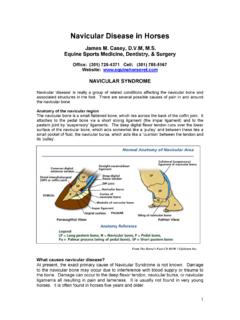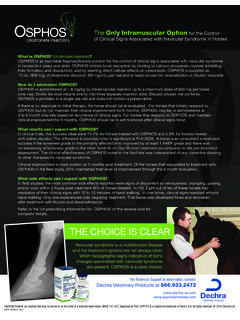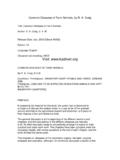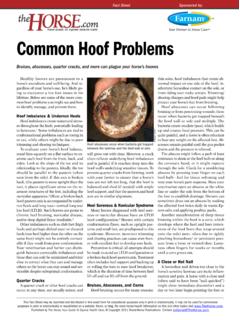Transcription of sTep by sTep TheHorse.com/step By step Guided Tour: horse ...
1 46 The horse January 2010sT ep by sT epClip. Clop. The simple hoofbeats of your moving horse effectively hide the highly complex anatomy and physiology at work inside his hooves dur-ing each step. As a horse owner/caretaker, knowing the basics of hoof anatomy and physiol-ogy can help you keep your horses sound and bring them back from lameness more quickly. Plus, it certainly helps to under-stand what the heck your veterinarian and/or farrier are talking about if your horse comes up Parks, MA, VetMB, MRCVS, Dipl. ACVS, professor of large animal sur-gery and head of the Department of Large Animal Medicine at the University of Geor-gia (UGA), puts it like this: Understanding anatomy is a prerequisite to understanding physiology.
2 Owners need to know what s in the foot for many day-to-day reasons; for example, if the horse steps on a nail, they need to know what structures might be damaged so they know how serious it could be. (Hint: A nail puncture in the middle third of the frog is particularly dan-gerous because the nail could damage sev-eral critical structures.)In this article, we ll take a tour of equine foot/lower limb anatomy and physiology with Parks as our guide. basic Anatomy/physiology Concepts I think of the horse s foot as a model, and try to envision the parts fitting to-gether from the inside out (starting with the bones), says Parks. Bones support weight and act as levers (soft tissues move them to mobilize the limb and, thus, the entire horse ).
3 The animal and its hooves get their basic structure from the bones (bone shapes vary, leading to variable hoof shapes). Then the bones have to articu-late (fit together), so you have joints. Joint shape depends on how the bones fit and move together. Ligaments hold bones to-gether at joints and control their range of motion (direction/distance of movement). But so far we still don t have any way to move those joints, which is where mus-cles and tendons come in they are the motors and pulleys of this mechanical system (tendons attach the muscles to bones), he adds. The muscles provide force to move joints and stabilize them. Then we have the nervous system with-in the foot, which controls its movement and also provides constant feedback to the animal regarding where the foot is, so he can correct its placement as needed, he says.
4 Lastly, there s the circulatory (blood) Learn how your horse s feet work so you can understand how to keep them soundGuided Tour: horse hoof Anatomy By CHrisTy horse s foot is comprised of parts that fit and work together from the inside out to support his weight and act as levers to move his BronkHorsT47 January 2010 The horse , which delivers nutrients, oxygen, and everything else the tissues need. bare bonesThe hoof contains two bones the cof-fin bone (also called the distal phalanx, distal meaning situated further away from the central part of the body) and navicular bone plus part of another, the short pas-tern bone (also called the second or middle phalanx). The latter is considered a long bone with a basically cylindrical shape that transmits force from one end to the other, with a joint at either end.
5 The coffin bone, however, has a joint at only its upper (prox-imal) end where it meets the distal end of the second phalanx. The other end attaches to modified skin (the hoof capsule).stabilizing and Moving the bonesThe horse moves when muscles in the upper limbs pull on the bones of the limb and hoof, bending or straightening the joints of the leg and lifting or lowering the hoof. The joints of the lower limb include the proximal interphalangeal joint (also called the pastern joint, where the second and first phalanxes come together) and the distal interphalangeal joint (also called the coffin joint, where the distal phalanx and second phalanx articulate). There is also the navicular joint between the navicular bone and distal phalanx, but that doesn t contribute to limb movement.
6 Each joint has a joint capsule (light yellow in the diagram above), which is a large capsule containing fluid to lubricate the joint. You can see on the diagram that the capsules extend a good distance up the dorsal (front) and palmar (rear) surfaces of the bones, as those are the directions of joint travel. The lower limb joints don t have much side-to-side motion, so the joint capsules don t extend as far up the sides (not visible on this diagram). Each joint is stabilized by ligaments strong bands of connective tissue with limited elasticity that hold the bones in po-sition (5 and 7 in the diagram). In conjunc-tion with the shape of the bones articular (joint) surfaces and the joint capsule, they control the directions in which the joint moves.
7 If you ve ever twisted an ankle, you know what happens when you damage these ligaments by flexing the joint hard in the wrong direction. The tendons that move joints by trans-mitting the muscles pull to lower limb bones (red bands in diagram) include the common digital extensor tendon and deep digital flexor tendon (DDFT). The first at-taches to the upper, front aspect of the cof-fin bone and straightens the lower limb just before the foot lands, while the latter runs down the back of the leg and over the navicular bone to attach on the bottom of the distal phalanx. The extensor tendon isn t critical to helping the horse stand, only to straighten the foot while moving, while the DDFT maintains the foot s position on the ground.
8 Thus, injury or disease of the DDFT apparatus tends to cause far more problems than extensor tendon the deep digital flexor muscle contracts and pulls on the DDFT, it raises the heels as the animal breaks over its toe. The navicular bursa, a fluid-filled sac (light yellow, indicated on diagram), de-creases friction as the tendon pulls around the navicular DDFT, along with the superficial digital flexor tendon and fetlock suspen-sory apparatus that attaches higher on the limb, is quite elastic and stretches like a rubber band when the horse lands on it. When the horse unloads the foot, the rubber band rebounds to its original length, returning some of that energy for the next stride. The powerful pressure of the DDFT on the navicular bone and bursa can contribute to injury or disease in the bone, bursa, or tendon; hence the term navicular syndrome for pain in this region.
9 This syndrome commonly affects horses with low-angled hooves and up-right pasterns (called a broken-back foot-pastern axis) and, thus, a sharper corner for the tendon to go around. hoof specificsBones, ligaments, and tendons exist throughout the horse s body, but within the hoof capsule are several structures unique to the hoof. We ll start with the collateral cartilages (seen in blue in the figures la-beled 3D Learning on page 48), which at-tach to the sides of the distal phalanx and act as flexible extensions of it, projecting upward and rearward. Their front halves attach to the distal phalanx, while the rear halves float free. They are thicker at the bottom, and their thinner upper edges can be felt above the coronary band.
10 Presum-ably, they are part of the mechanism that allows the foot to expand slightly (1-2 mm) with weight-bearing. The term sidebone describes collateral cartilages that have hardened into bone, often from repeated concussion on hard the collateral cartilages and on top of the frog lies the digital cushion (6 in the diagram above, but also see the pink structure under 3D Learning on page 48), which true to its name is a fibrous, fibrocartilaginous, and elastic structure that helps absorb the shock of landing. The bones And sTruCTures of The fooTdr. roBin PeTerson illusTrATionsP1P231 - Navicular bone2 - Coffin bone (P3)3 - Frog4 - Deep digital flexor tendon5 - Collateral ligament of navicular bone 6 - Digital cushion 7 - Sesmoidean ligaments 8 - Superficial digital flexor tendon 9 - Common digital extensor tendon10 - Navicular bursa12P1P26 Fetlock jointPastern jointCoffin jointMC3445758910 Laminae48 The horse January 2010sT ep by sT epHorses with sound, healthy feet have thick collateral cartilages and digital cushions, while those with low heels and flat soles often have thin collateral cartilages and a thin/crushed digital cushion that can t ab-sorb as much energy as it should.








